My first dessert recipe! I call it Okinawan Sundae as I had this ice cream with corn flakes, soybean flour and brown sugar syrup in Okinawa earlier this year when I travelled to the southern part of Japan. The combination of roasted soybean flour and brown sugar syrup is wonderful and they go so well with vanilla ice cream. It wouldn’t be an Okinawan ice cream dessert without corn flakes.
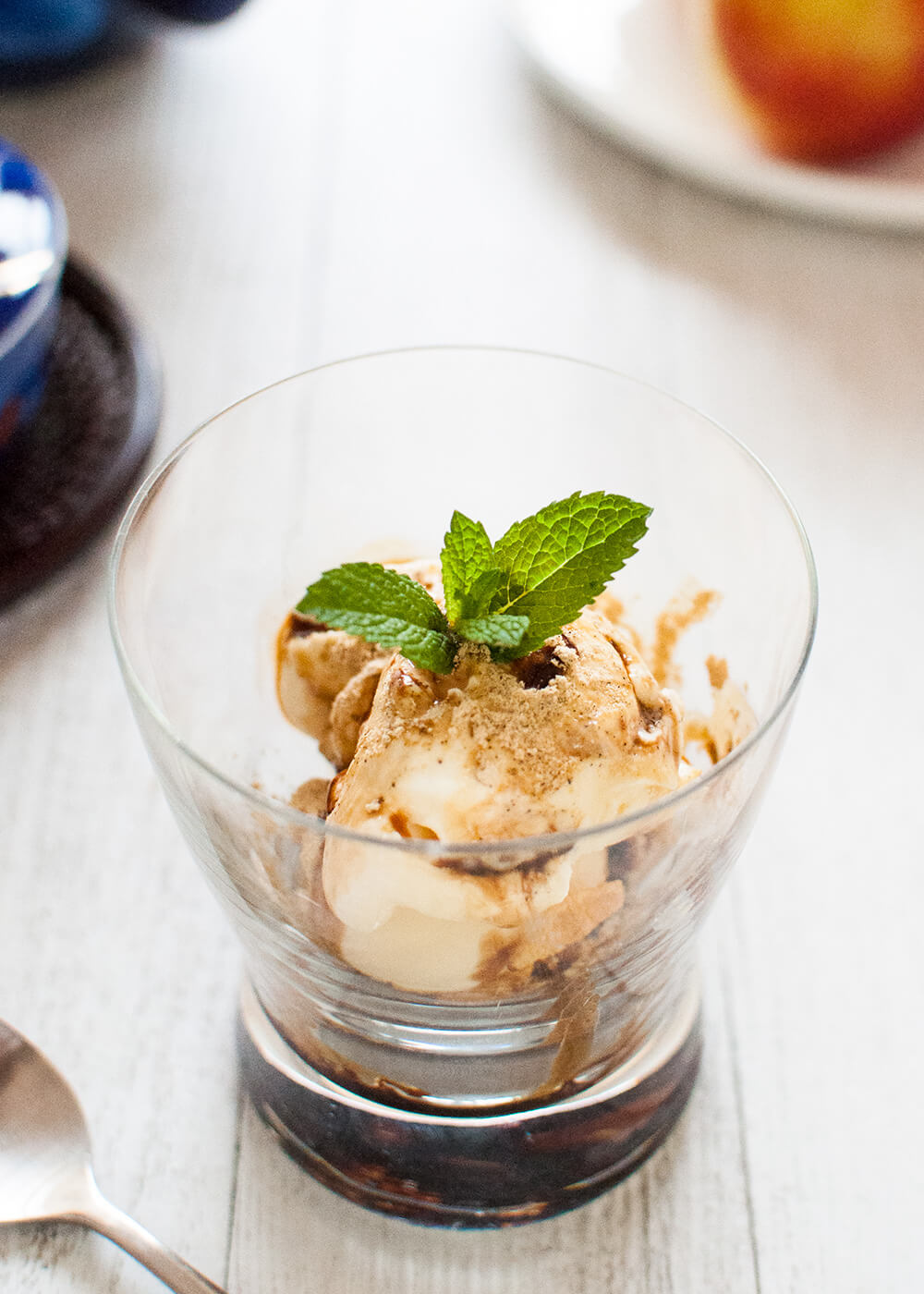
When I travelled to the Okinawa Islands with friends in late January to early February this year, the first island we stayed on was Ishigaki Island, which is west of Okinawa main island, about a 1 hour flight from mainland Okinawa. It is known for its beautiful beaches and water sports.
My friends had limited knowledge about Japan and speaking Japanese was out of question. So I became the tour guide. I have been to Okinawa several times but my previous trips were mostly for scuba diving, not sightseeing. I once went to Naha, capital city of Okinawa, with my children but I had never been to Ishigaki island.
As a tour guide, I felt responsible for knowing good places to take my friends. So, when we got in the taxi from Ishigaki airport to our minshuku (民宿, family-run lodgings), I asked the driver which restaurants would be good to go to. He mentioned a small restaurant near our minshuku where only the locals and tour guides go. He also told me to try the izakaya (居酒屋, Japanese-style tavern) called Hitoshi (ひとし) as its specialty is tuna dishes.
We had great dishes at Hitoshi and to wrap up our first dinner on Ishigaki island, we all ordered vanilla ice cream for dessert. This dessert was a big surprise. Firstly, it had roasted soybean flour and Okinawan brown sugar syrup as toppings and they added so much flavour to the simple vanilla ice cream.
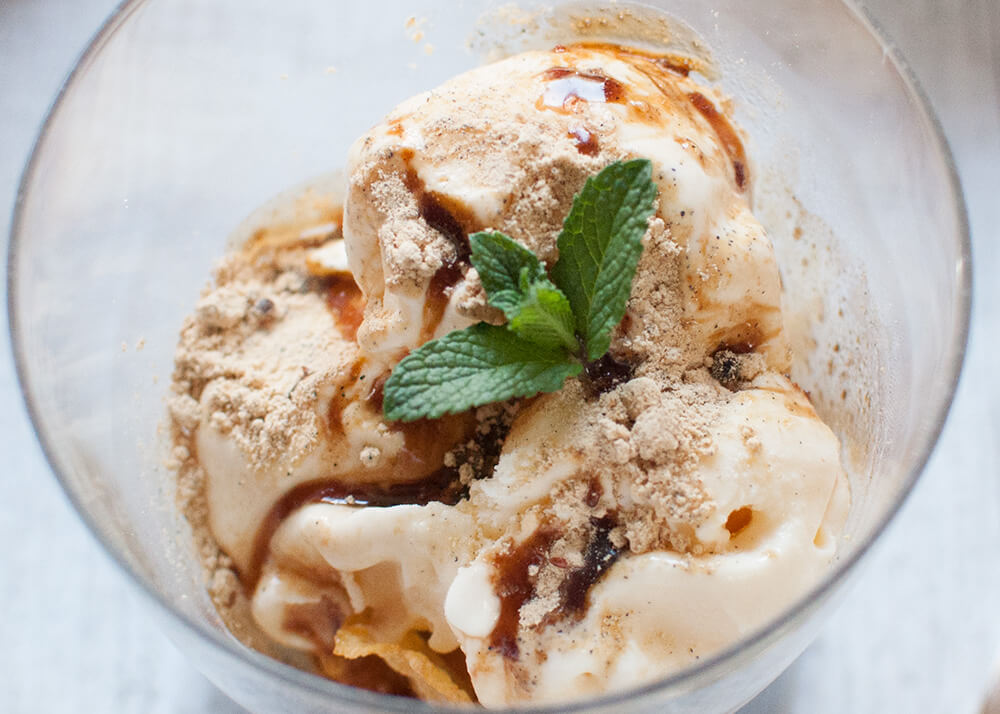
As we dug into the bottom of the bowl, we found plain corn flakes. The crunchiness of the corn flakes added a different dimension to the texture and it surprisingly went so well with the ice cream. Who would have thought of adding corn flakes to the ice cream?
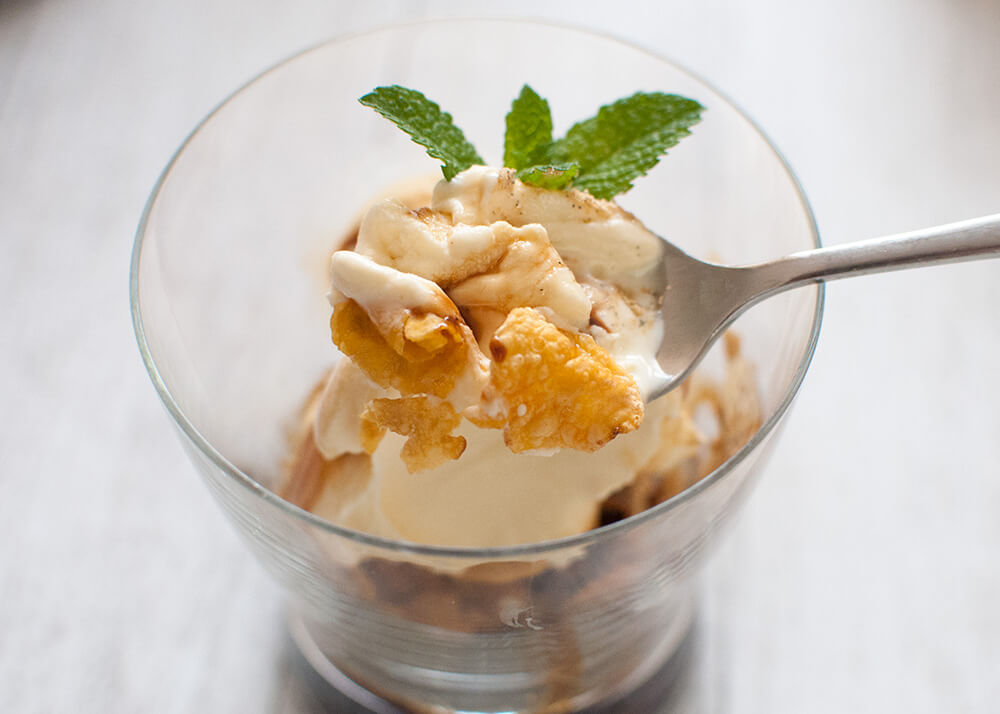
A couple of months later, I made this memorable ice cream dessert to test out the flavour. The brown syrup was made from Okinawan dark brown sugar, which is made purely from sugar cane in Okinawa. You can buy a bag of Okinawan dark brown sugar at Japanese grocery stores or from Amazon. It is called ‘Yanbaru tō’ (やんばる糖) – see the right photo below. Yanbaru is the name of the region within Okinawa where the dark brown sugar is produced, and ‘tō’ (糖) means sugar.
It comes in powder form as well as in blocks. I bought the powdered sugar as it melts more quickly. But you can make syrup from blocks of sugar as well. It just takes longer to dissolve the sugar.
It does not have to be Okinawan sugar. I also made syrup using dark brown sugar. But I think that the syrup made from Yanbaru tō was milder in flavour and had less caramel taste compared to the syrup made from brown sugar.
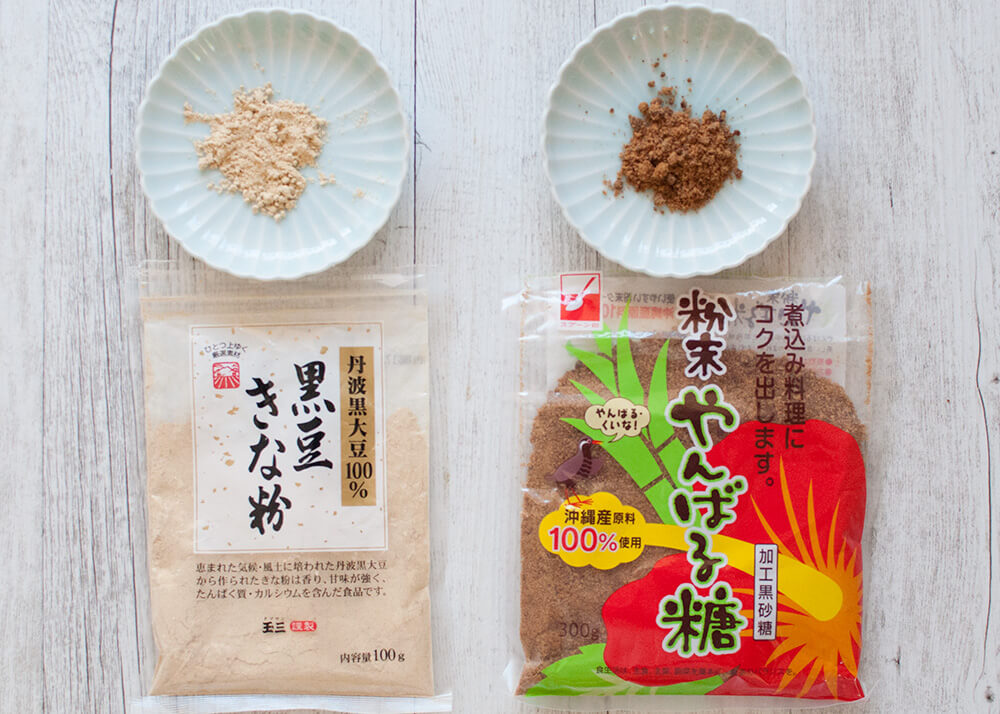
Rostead soybean flour (kinako) on the left, Okinawan brown sugar (Yanbaru tō) on the right.
Roasted soybean flour is also sold at Japanese grocery stores as well as from Amazon. It is called kinako (きな粉) in Japanese. Kinako is produced by finely grinding roasted soybeans into powder. You might also find kinako made from black soybeans. Both look similar but the nutrients are slightly different. My kinako was made from black soybeans. See the left photo above.
Unlike other flours, such as corn flour and wheat flour, you can eat roasted soybean flour raw. It contains protein, fibre and other good nutrients.
In Japan, kinako is traditionally used for Japanese desserts, wagashi (和菓子) and sticky rice cakes or dumplings. But these days, even professional sportspeople drink milk mixed with kinako for effective nutrient intake.
You cannot substitute kinako for normal soybean flour as normal soybean flour should not be eaten without cooking. Kinako is a rather unique ingredient to keep in a pantry but I hope you try kinako as it makes this dessert very special.
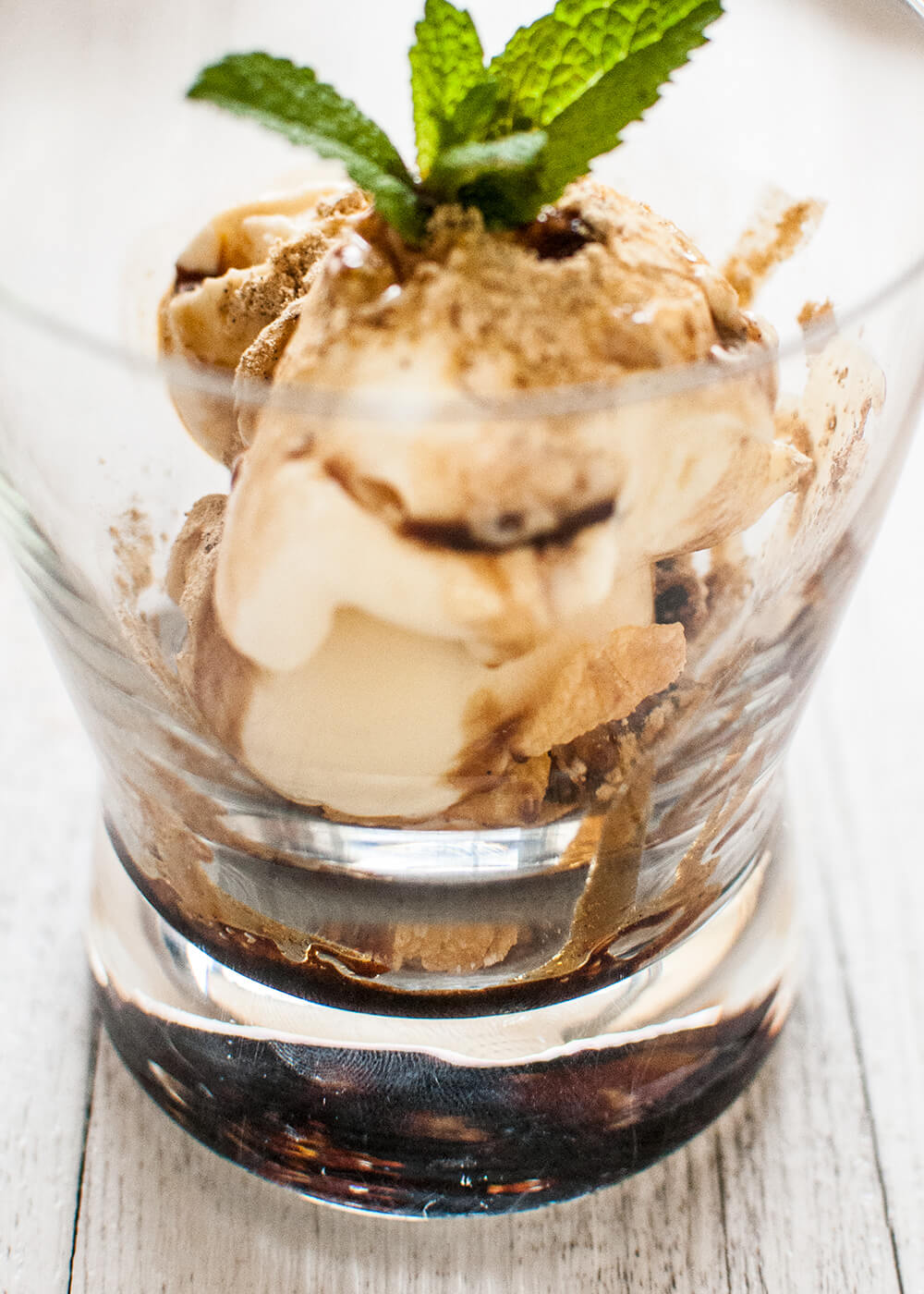
To tell you the truth, I was not planning to post Okinawan sundae because I thought it was too simple. But my friends convinced me to post the recipe.
I recently hosted the card night that is one of our social group events. There were 12 people including me (I don’t play cards at all but I had to play to make up the numbers!) and I was responsible for serving nibbles, the main meal and dessert.
I had no problem figuring out the nibbles and main but I was wondering what to do with dessert as I hardly eat or make dessert. I wanted delicious desserts for the least amount of effort to serve a dozen people. So, I decided to serve this dessert.
Everyone liked it and asked me if I would be posting the recipe. I said no but asked them if I should post it. They all said in unison, “of course, you should!”. So, here it is. Simple dessert, Okinawan Sundae.
Yumiko![]()
P.S. Nagi was extremely doubtful about this Okinawan Sundae. Obviously, she has no faith in me when it comes to dessert. But I asked her to try it. Nagi was actually surprised that it was quite tasty and kinako goes very well with the syrup. She also liked the crunchiness of the corn flakes. So, this dessert has Nagi’s approval!
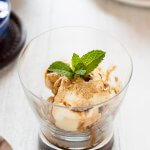
My first dessert recipe! I had this in Okinawa. The combination of roasted soybean flour and brown sugar is wonderful and they go so well with vanilla ice cream. It wouldn’t be an Okinawan ice cream dessert without corn flakes.
- 1 heaped tbsp corn flakes
- 2-3 scoops of vanilla ice cream (note 1)
- ½ tbsp kinako (roasted soybean flour, note 2)
- 1 tbsp brown sugar syrup
- 1 small sprig of mint leaves as garnish (optional)
- 100 g (3.5oz) Yanbaru powder sugar (note 3)
- 60 ml (2oz) water
-
Place corn flakes in the bottom of a tumbler glass, small bowl or a cup.
-
Add 2-3 small scoops of vanilla ice cream on top.
-
Sprinkle kinako over the ice cream, then top with the syrup.
-
Combine the sugar and water in a small saucepan and bring it to a boil.
-
Reduce the heat to low to simmer and cook for about 5 minutes. When you tilt the pan, and draw a horizontal line on the upper part of the bottom of the pan, the line should stay.
-
Turn the heat off and let it cool down.
1. My ice cream scoop was small and each ice cream ball was about 4cm (1½") in diameter. If you are using a large scoop, you will only need one or two scoops.
If you use Nagi’s recipe to make vanilla ice cream, which is explained in note 4 of the recipe Home Made Mango Ice Cream Recipe, it will be even better!
2. You can buy kinako (roasted soybean flour) from Japanese grocery stores. Amazon also sells it on-line. Kinako is made from either normal soybeans or black soybeans. Either beans are OK.
You cannot substitute kinako with normal soybean flour as the latter is not cooked and you should not eat it raw.
3. You can buy Yanbaru sugar from Japanese grocery stores or from Amazon. It comes in powder form as well as in blocks. If you use the sugar in block form instead of powder, it takes a bit longer to dissolve.
You can substitute dark brown sugar or brown sugar for Yanbaru sugar but the flavour and the colour of the syrup will be a bit different.
Additional note reflecting a reader's comment on 3 Aug 2023 (thanks Lynne): If you have access to Mexican or possibly other Hispanic markets, use piloncillo instead of American brown sugar. It comes in a solid chunk, so you have to grate it, but it is probably much closer to the Okinawan sugar than American brown sugar, which is white sugar with molasses added.
This sounds amazing and I am glad that you posted it. I am also glad that you had Nagi try it!! I will try this also.
Thank you,
Sandra
Hi Sandra, yes, it’s a Nagi-approved Sundae!
I lived in Okinawa as a child in the 70’s. There was this wonderful bread I use to purchase that was white with a wonderful pink swirl in the middle. I have looked everywhere for a description or recipe. Have you seen or heard of it? I am so excited to try many of your recipes!!
Hi Anita, unfortunately I haven’t seen a bread like that. But I did Google search in Japanese and I can see various kinds of bread with pink swirl. If you call up Google images and copy this Japanese words within quotes,’ピンク渦巻きパン’, and paste it in the search field, you will see them.
Hi Yumiko-San,
I’m an Okinawan living in the UK who loves eating. I was looking for a Gai Yang recipe and fell onto Nagi-san’s recipe. As I usually prefer to use authentic recipes, I wanted to know the author of the recipe and caught by a surprise it was posted by a Japanese lady. Anyway, I was curious what kind of Japanese recipes are on here, and couldn’t resist to click this recipe as it says “Okinawan Sundae”. I wondered what OKinawan sundae is thinking such thing doesn’t really exist. As I read your blog, it reminded me of this same dessert I used to eat and like in Izakayas in Okinawa more than 10 years ago. I didn’t realize at that time it was something “Okinawan” though. I may try one day after I get “Yanbaru to” from Okinawa. Thank you for the post. I will go back to Okinawa in August and will visit Ishigakijima for the first time. “Hitoshi” is one of my must go lists.
Hi Makiko-san, I called it ‘Okinawan’ simply because we had it there and it uses Yanbaru-to. Also use of corn flakes is a kind of American influence, I thought. Ishigaki was really great and we all enjoyed immensely – beautiful beaches, islands, great seafood as well as Ishigaki beef. Dishes at Hitoshi was so good that we actually went there twice. For the second dinner there, I pre-ordered a grilled tuna collar (tuna collar). It was so good. And of course we had sundae again. Have a wonderful trip back to Okinawa!
Hi Yumiko, I just wanted to say hello and that I will not be able to make this which sounds soooo! good. When reading it as you explained the crunch of the corn flakes I thought oh no. I know of only one corn flake cereal very popular, and it will go limp in 10 -15 seconds after the milk is poured. Then I went to Amazon found the price of soybean flour okay but the sugar $25.00 for 1 cup. I forgot to tell you I’m in the U.S. Anyway, I want to thank you for your in depth pantry definitions. You went the extra mile and I am learning so much as I want to cook stir fry’s and other things. I have not been able to read to many of your recipes because your daughter who is adorable has me addicted to her website,(found in Aug). Don’t tell Nagi, but I am searching yours first for stir fry, ha!ha!. Kidding, I know she won’t mind..I will get back to hopefully soon.
Hi Claudia, thanks for dropping by. Surprisingly, corn flakes do not go soggy with ice-cream on it. and instead of Yanbaru sugar, you can use dark brown sugar which I presume you can get from super market. I tried that and it is still yummy.
What a wonderful combination of textures and flavors. Like you, I’m not a dessert person, but as I read your post I found myself wanting this. Getting the Yanbaru powdered sugar might prove daunting here. Do you think a dark brown beet sugar could work?
Hi Ron, even if I am not a dessert person, I don’t mind having this sundae occasionally. Dark brown beet sugar should work. Flavour might be slightly different but you’ll get the idea!
I have always loved pretty much anything sweet, so this sounds like something I would like to try! Also, my husband likes trying things with ingredients he has never tasted before. I also like “simple” recipes, as you call it, because sometimes I like quick and easy when I want to fix something. Thanks for sharing this recipe with us.
Hi Naomi, I hope you and your husband like it!
For those with access to Mexican (or possibly other Hispanic markets) I would suggest using piloncillo instead of American brown sugar. It comes in a solid chunk, so you have to grate it, but it is probably much closer to the Okinawan sugar than American brown sugar, which is white sugar with molasses added. See here for information on piloncillo: https://www.thespruceeats.com/how-to-use-piloncillo-2343039
Hi Lynne, thanks for the information on the alternative sugar. Okinawan sugar is from sugar cane, so piloncillo would taste almost the same. They do look the same too. I will add this to my recipe card.
Okinawan sugar is also sold as bite-size solid chunks. The idea is to eat it like a candy!